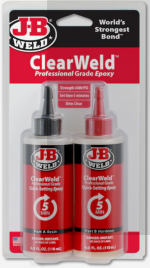Packard
Member
I bought a package of Loctite 5-minute Epoxy Adhesive.
The adhesive worked fine. The problem with it is that it comes with two nozzles that automatically swirl the epoxy together in exacting amounts. It mixes much like vanilla and chocolate soft ice cream does.
The problem is, you get only two drinks from the well. In my case, I used so little in the first application and the second project was going to require even less. So it would cost 4.50 per use.
Instead, I tried squeezing out a large glob and mixing it manually. The resulting glob never cured.
So while the self-mixing is very convenient, it can be very expensive to use. You cannot reuse the nozzles as the adhesive cures inside.
So now I am going to buy a package that features manually mixing the adhesive and hardener to re-glue the small project. I will use the remaining nozzle when I have a larger project to glue.


The adhesive worked fine. The problem with it is that it comes with two nozzles that automatically swirl the epoxy together in exacting amounts. It mixes much like vanilla and chocolate soft ice cream does.
The problem is, you get only two drinks from the well. In my case, I used so little in the first application and the second project was going to require even less. So it would cost 4.50 per use.
Instead, I tried squeezing out a large glob and mixing it manually. The resulting glob never cured.
So while the self-mixing is very convenient, it can be very expensive to use. You cannot reuse the nozzles as the adhesive cures inside.
So now I am going to buy a package that features manually mixing the adhesive and hardener to re-glue the small project. I will use the remaining nozzle when I have a larger project to glue.


